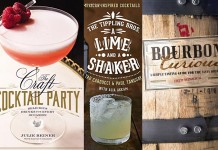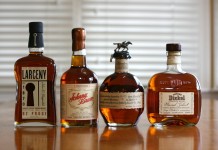
Of the many sugarcane-based spirits on the market, Cachaça has had one of the tougher roads with US consumers. Despite both Sagatiba and Leblon Cachaça making significant efforts to cultivate the market in the US, including a protracted battle with the US government to get cachaça accepted as its own spirits category (versus being labeled “Brazilian Rum”), the category has had significant downward velocity with sales shrinking dramatically in 2012 and 2013. Cachaça’s struggle is unfortunate as it is a spirit that can capture a really beautiful expression of pure sugarcane. Like Rhum Agricole, Cachaça is made from freshly pressed sugarcane and showcases the wonderful grassy and vegetal qualities of sugarcane. Cachaça is also the key ingredient in the Caipirinha cocktail, a beautifully simple cocktail that includes lime, sugar, and cachaça.
Given the cachaça market’s dramatic decline, it’s surprising that anyone would be bold (or perhaps crazy) enough to release a new cachaça aimed at the US market. Three New York-based entrepreneurs – Nate Whitehouse, Pete Nevenglosky, and Mark Christou – are the bold and crazy guys behind the recently released Avuá Cachaça. The trio took a different approach to the cachaça market by working with a small artisan Brazilian distiller, one of the few female ones, to make two unique cachaça expressions. The first Avua expression, called Avua Prata, is rested in stainless steel casks for six months, while the other, Avua Amburana, is aged in a rare Amburana Brazilian hardwood casks for up to two years. Each expression of Avua is hand bottled and numbered in funky retro 80s style bottles that look like a cool riff on the Bols liqueur bottles.
Avuá Cachaça Prata (42% AVB / 84 proof, $30.99) – fresh cut sugarcane comes bursting out of the glass: sweet, grassy, slightly floral, and absolutely inviting. Behind the sugarcane is a deep bready, yeasty note which marries very well with the sugarcane. One of the things we really like about the nose on the Prata is that it reads both as sweet and dry, a very difficult balance to strike, and Prata does it very well. The nose also reflects really exceptional distilling as it has absolutely no vapors or sharp edges. The entry for Avua Prata is a lot lighter and drier than we expected. While it does open with the sugarcane note from the nose, it’s not as deep or expressive, or as vegetal, as it is in the nose. In the midpalate the sugarcane reads more like pure sugar and is joined by an increasing dry pepper spice. Avua does a really nice job in the midpalate of balancing the sweet and spicy notes, but that balance ends as the the pepper increases dramatically at the end of the midpalate. This dry spice drives a fairly spicy and very dry finish.
There’s something about the way that Avua Cachaça Prata blends the sweet of the sugar with spice that reminds us of some of the American Moonshine releases, and that’s probably no accident. Avua Prata has clearly been designed with cocktails in mind and even more specifically, the American Craft Cocktail movement. Avua trades some of the wonderful aromatics in the nose and palate for a much drier and mixable profile, and at 42% AVB it’s clear that Avua Prata’s drier character is a deliberate choice. In the midpalate Prata really succeeds with a superb balance of sweet and spicy, but the finish is little too dry, and when mixed with citrus it really requires a lot more sweet to balance it out.
Avuá Cachaça Amburana (40% AVB / 80 proof, $54.99) – conventional wisdom was that the TTB (Alcohol and Tobacco Tax and Trade Bureau) prohibited the aging of spirits in rare hardwoods, but when Avua Cachaça co-owner Pete Nevenglosky did some digging, he found that they could indeed use Amburana, a traditional Brazilian hardwood, to age their cachaça. The result is Avuá Cachaça Amburana, one of the more distinct and unique cachaças we’ve tried. Pale yellow in color, the nose on Amburana has some of the same qualities as Prata, including the grassy sweet sugarcane note, light flowers, and a bready, yeasty note, but there’s a lot more added to the equation, including a great deal of cinnamon and nutmeg spice as well as a faint burnt sage note.
A woody cinnamon note, more like cinnamon bark or cinnamon stick, drives the entry. The yeasty note which was both on the nose of the Prata and the Amburana is dramatically more present on the palate here along with the grassy sugarcane note. There’s a charred element to the opening which tastes like the sugarcane was burned before it was pressed (although we suspect that it’s really coming from the barrel). The midpalate brings in more spice to the equation including black pepper, but it’s far less spicy than in the midpalate of the Prata. In the midpalate there’s also a soft honey note which complements the sweet sugarcane and balances with the pepper and cinnamon spice. The finish is fairly long with the woody cinnamon sticking around for quite a long time combined with the grassy sugarcane from the nose. Amburana is at a lower proof than Prata, and so it has a more lush and less dry finish.
Both the Avuá Cachaça Prata and Amburana are well made products. The big question is: will they find success in a category where so many have failed? Unfortunately, we fear the answer is no. While Avua Prata seems to be well in line with the price of other artisan cachaças on the market, like Novo Fogo, Amburana, which is over the $50 mark, is simply priced too high. This creates a conundrum for many craft cocktail bartenders who will surely like the unique flavor experience of Amburana but be extremely limited in using it because of its cost. The bigger and much bleaker picture is really the broader cachaça market: outside some key areas of the country with strong Brazilian populations, cachaça just isn’t finding traction. Even with a quality cachaça, the fight to find an audience is an extreme, un-ending, uphill battle, much more suited for Sisyphus than a small group of New York entrepreneurs.















